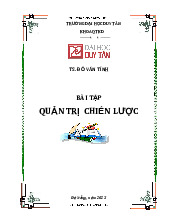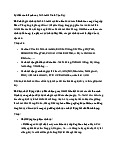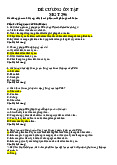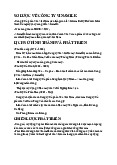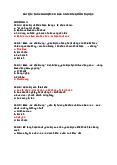



















Preview text:
PART I: MULTIPLE CHOICE
CONT.1: MANGEMENT AND MANAGERS
Q1001. Lotte developed a fat-fryer machine that reduced the amount of oil used to fry
burgers by 35 percent over its current competitors. This is an example of an attempt to improve the organization's: A. effectiveness. B. efficiency. C. planning. D. organizing. A1001:B Learning objective: 01
Q1002. Four managerial functions arrange in order:
A. Organizing, Planning, Controlling, Leading
B. Organizing, Leading, Planning, Controlling
C. Planning, Organizing, Leading, Controlling
D. Planning, Organizing, Controlling, Leading A1002: C Learning objective: 01
Q1003. A person who is responsible for supervising the organization's use of its resources is known as: A. managers. B. normalisers. C. precisionist. D. strategists. A1003: A Learning objective: 01
Q1004. Which managers are often called supervisors ? A. First-line B. Middle C. Top D. Interim A1004: A Learning objective: 01
Q1005. The top managers are responsible for the performance of all the departments in an
organization, this is another way of saying that they have:
A. restructuring responsibilities. B. technical responsibilities. C. global responsibilities.
D. cross-departmental responsibilities. A1005: D 1 Learning objective: 01
Q1006. Which of the following includes the ability to understand, lead, and control the behavior of other workers? A. Human skill B. Communication skill C. Conceptual skill D. Technical skill A1006: B Learning objective: 01
Q1007. The ability of a accountant related to prepare the organization's balance sheet is an example of a(n): A. critical thinking skill. B. conceptual skill. C. technical skill. D. human skill. A1007: D Learning objective: 01
Q1008……….. involves simplifying, shrinking, or downsizing an organization's operations to lower operating costs. A. Outsourcing B. Restructuring C. Streamlining D. Insourcing A1008: D Learning objective: 01
Q1009. The trait of a person that is feelling good about himself and the rest of the world is known as: A. conscientiousness. B. openness to experience. C. positive affectivity. D. extraversion. A1009: D Learning objective: 01
Q1010. Trait of a manager to get along well with other workers is known as: A. positive affectivity. B. agreeableness. C. conscientiousness. D. extraversion. A1010: B 2 Learning objective: 01
Q1011. Tom is often criticized by his manager as an individual who lacks direction and self-
discipline. If this opinion is true, Tom would score: A. low on conscientiousness.
B. low on openness to experience.
C. low on negative affectivity. D. low on agreeableness. A1011: A Learning objective: 01
Q1012. Managers who initiate major changes in their organizations are often high on: A. intraversion. B. overview. C. conscientiousness. D. openness to experience. A1012: D Learning objective: 01
Q1013. Organizational culture includes the following factors EXCEPT: A. rites. B. stories. C. language. D. technology. A1013: D Learning objective: 01
Q1014. The process by which newcomers to an organization learn the values and norms is: A. extraversion.
B. organizational socialization. C. conscientiousness. D. openness to experience. A1014: B Learning objective: 01
Q1015. Determine how individuals enter, advance within, or leave the organization is called rite of…….. A. passage B. integration C. ceremony D. enhancement A1015: A 3 Learning objective: 01
CONT.2: THE ENVIRONMENT OF MANAGEMENT
Q1016. For HP Computer, the educational institutions that train future HP employees are: A. competitors B. distributors C. customers D. suppliers A1016: D Learning objective: 02
Q1017. Individuals or organizations that help other organizations to sell their product or
service to customers are known as: A. competitors. B. potential competitors. C. distributors. D. customers. A1017: C Learning objective: 02
Q1018. In a particular task environment, organizations are not currently selling goods but
they could enter this environment in the future if they wanted to are known as: A. customers. B. potential competitors. C. distributors. D. competitors. A1018: B Learning objective: 02
Q1019. Factors that make it costly for an organization to enter an industry as a new competitor are known as: B. government regulation. C. brand loyalty. D. technological forces. A. economies of scale. A1019: B Learning objective: 02
Q1020. In general, the………….the barriers to entry into an industry, the……….the number
of competitors in that industry and the _____ the threat of competition within that industry. A. higher; greater; lower B. lower; smaller; lower C. higher; greater; smaller D. lower; greater; higher A1020: C 4 Learning objective: 02
Q1021. Unemployment is an example of a (an) ____ force in an organization's environment. A. socio-economic B. economic C. demographic D. political A1021: B Learning objective: 02
Q1022. The combination of equipment that managers use in the production and distribution of goods is known as: A. brand loyalty. B. inflation. C. competition. D. technology. A1022: D Learning objective: 02
Q1023. The collection of values that a society considers important and the norms of behavior
that are approved by the society are known as: A. political-legal forces. B. economics forces. C. the national culture. D. the general environment. A1023: C Learning objective: 02
Q1024. The population of the VietNam is shifting from the Ha Noi capital to the Da Nang
city. This is an example of which type of force in the environment? A. Legal B. Sociocultural C. Economic D. Demographic A1024: D Learning objective: 02
Q1025. Laws and policies of government are a part of which of the following force? A. Political and legal B. Technological C. Sociocultural D. Economic A1025: A 5 Learning objective: 02
Q1026. If a society believes that subordination of individual with group is important to the
people in that society, then the society is said to value: A. collectivism. B. individualism. C. a free-market economy. D. a free-trade doctrine. A1026: A Learning objective: 02
Q1027. The degree to which people in a society accept the idea that inequalities in the well
being of its citizens are due to differences in people's intellectual capabilities is known as: A. referent power. B. absolute power. C. free-market power. D. power distance. A1027: D Learning objective: 02
Q1028. A society that focuses "living for the present" is said to have: A. high power avoidance. B. low power avoidance. C. long-term orientation. D. short-term orientation. A1028: D Learning objective: 02
Q1029. Which of the following is considered to be a stakeholder of an organization EXCEPT? A. Community B. Society C. Customers D. Government A1029: D Learning objective: 02
Q1030. The stakeholder group with the most responsibility for deciding the goals of the organization are: A. suppliers. B. customers. C. managers. D. community. A1030: C 6 Learning objective: 02 CONT.3: DECISION MAKING
Q1031. Minh Toan Group’s accounting department decides to send out a bill to a new
customer. What type of decision does this represent? A. Programmed B. Nonprogrammed C. Intuitive D. Groupthink A1031: A Learning objective: 02
Q1032. Hong Hanh, a manager, orders raw materials when the raw materials inventory
reaches a certain point. This is an example of which type of decision? A. Intuition B. Satisficing C. Nonprogrammed D. Programmed A1032: D Learning objective: 02
Q1033. William decides to hire temporary help when the regular secretary goes on vacation.
This is an example of which type of decision? A. Programmed B. Groupthink C. Nonprogrammed D. Intuition A1033: A Learning objective: 02
Q1034. Alex, an accountant for a small firm, pays the real estate taxes ten days before they
are due. This represents which type of decision? A. Satisficing B. Programmed C. Intuition D. Nonprogrammed A1034: B Learning objective: 02
Q1035. What do managers do to solve programmed decision? A. Create a mission statement
B. Establish rules and guidelines
C. Create cross-functional teams
D. Facilitate a strong organizational culture A1035: B 7 Learning objective: 02
Q1036. Which of the following is a programmed decision? A. Invest in a new product B. Expand into a new market
C. Build a new advertising campaign D. Send bills to customers A1036: D Learning objective: 02
Q1037. Nonroutine decisions are made in response to unusual, unpredictable opportunities and threats are known as: A. creative decisions. B. programmed decisions. C. heuristic decisions. D. nonprogrammed decisions. A1037: D Learning objective: 02
Q1038. NEM Company is trying to decide whether or not to launch nationally a new product
that this organization has never sold previously. This represents which type of decision for the organization? A. Programmed B. Intuition C. Groupthink D. Nonprogrammed A1038: D Learning objective: 02
Q1039. In biotechnology, managers know that new drugs have a 20% chance of passing
advanced clinical trials. This is an example of: A. risk. B. uncertainty. C. bounded rationality. D. incomplete information. A1039: A Learning objective: 02
Q1040. When managers cannot estimate probabilities of future occurrence to possible
alternatives to a decision, this is known as: A. certainty. B. risk. C. bounded rationality. D. uncertainty. A1040: D 8 Learning objective: 02
Q1041. The last step in the managerial decision-making process is to: A. generate alternatives. B. learn from feedback.
C. recognize the need for a decision.
D. implement the chosen alternative. A1041: B Learning objective: 02
Q1042. Which of the following is a reason that group decision-making is superior to
individual decision-making EXCEPT? A. Fewer biases and errors
B. More feasible alternatives generated C. Groupthink
D. Correction of each others' errors A1042: C Learning objective: 02
Q1043. A technique which managers use to meets face-to-face and generates and debates
many alternatives to make a decision. What is this process called? A. The Delphi technique B. Dialectical inquiry C. Brainstorming D. The nominal group technique A1043: C Learning objective: 02
Q1044. Which of the following is a way to group members do not met face to face ? A. Brainstorming B. Dialectical inquiry C. The Delphi technique D. Nominal group technique A1044: C Learning objective: 02
Q1045. The process which managers attempt to improve the ability of subordinates to
understand and to manage the organization is known as: A. learning organization. B. production blocking. C. groupthink. D. organizational learning. A1045: D 9 Learning objective: 02 CONT.4: PLANNING
Q1046: The cluster of decisions that managers make to assist the organization to achieve its goals is known as: A. strategy. B. organizing. C. controlling. D. related diversification. A1046: A Learning objective: 03
Q1047: A broad statement of the organization's overriding purpose, intended to identify the
organization's products and customer base, as well as to differentiate the organization from its competitors is known as: A. a functional-level plan. B. a mission statement. C. diversification.
D. a focused low-cost strategy. A1047: B Learning objective: 03
Q1048: Another name for the divisional level of the organization is the: A. functional level. B. departmental level. C. corporate level. D. business level. A1048: D Learning objective: 03 10
Q1049: General Electric Company sets a goal that every product line of the company should
be either first or second in its industry in market share. What type of goal does this represent? A. Corporate-level B. Divisional-level C. Functional-level D. Business-level A1049: A Learning objective: 03
Q1050: Which type of strategy states the methods that a division within an organization will
use to compete against its rivals in the industry? A. Functional-level strategy B. Corporate-level strategy C. Business-level strategy D. Top-level strategy A1050: C Learning objective: 03
Q1051: A written set of instructions which describes the series of actions that a manager
should take in a specific situation is known as: A. a policy.
B. a standard operating procedure. C. a rule D. a rolling plan. A1051: B Learning objective: 03
Q1052: A group of managers at Vin Group analyzes both the internal strengths and
weaknesses of their organization as well as the opportunities and threats of the external
environment. What type of analysis is this? A. Mission analysis B. SWOT analysis C. Functional analysis D. Diversification A1052: B Learning objective: 03
Q1053: While conducting the analysis, the fact that the company's product lines are strong
can be categorized under which of the following? A. Weakness B. Strength C. Threat D. Alternative 11 A1053: B Learning objective: 03
Q1054: While conducting a SWOT analysis, "poor marketing plan" would be categorized under which of the following? A. Strength B. Weakness C. Opportunity D. Threat A1054: B Learning objective: 03
Q1055: Vietjet Air attempts to gain a competitive advantage by driving down its production
costs per unit below those of its competitors. Which of the following strategy is Acme Explosives pursuing?
A. Focused differentiation strategy B. Low-cost strategy
C. Related diversification strategy
D. Unrelated diversification strategy A1055: B Learning objective: 03
Q1056: An organization attempts to succeed by distinguishing its products from those of the
competition. What type of strategy is this? A. Differentiation strategy B. Low-cost strategy
C. Related diversification strategy
D. International expansion strategy A1056: A Learning objective: 03
Q1057: Audi produces cars exclusively for high-income customers. Which of the following strategy is Audi pursuing? A. Focused differentiation B. Focused low - cost C. Diversification D. Differentiation A1057: A Learning objective: 03 12
Q1058: The Be Knife Company aims at a market of hunters, and they try to keep prices lower
than competition. Which of the following strategy is Beswick pursuing? A. Low-cost B. Differentiation C. Focused low-cost D. Focused differentiation A1058: C Learning objective: 03
Q1059: PepsiCo purchased KFC so that it could replace Coke products with Pepsi products
in KFC restaurants. This was an example of: A. horizontal integration. B. vertical integration. C. a low-cost strategy. D. a global strategy. A1059: B Learning objective: 03
Q1060: When PepsiCo purchased Frito-Lay and expanded its operations into the snack-food
business, which of the following strategy did is pursue? A. International expansion B. Market penetration C. Diversification D. Market development A1060: C Learning objective: 03 CONT.5: ORGANIZING
Q1061: The process by which managers establish the structure of working relationship
among workers of the organization is known as: A. strategy. B. leading. C. organizing. D. controlling. A1061: C Learning objective: 03
Q1062: The process by which managers decide how to divide into specific jobs the tasks that
have to be performed to provide customers with goods and services is known as: A. job design. B. job enlargement. C. task significance. D. organizing 13 A1062: A Learning objective: 03
Q1063: KFC divides the tasks of "chefs" and "food servers" into two jobs in its restaurants. This is an example of:
A. continuous-process technology. B. job design. C. divisional structure. D. product structure. A1063: B Learning objective: 03
Q1064: A manager increases the number of tasks that a subordinate has to do in order to
make the job more interesting for the subordinate. Which of the following best describes this process? A. Job simplification B. Job enlargement C. Job enrichment D. Feedback A1064: B Learning objective: 03
Q1065: A manager redesigns the job of a subordinate so that the subordinate has more
responsibility over his or her job. Which of the following best describes this process? A. Job enlargement B. Job simplification C. Job enrichment D. Job design A1065: C Learning objective: 03
Q1066: Which of the following is an organizational structure composing of all the
departments that an organization requires to produce its goods or services? A. Continuous-process B. Divisional C. Matrix D. Functional 14 A1066: D Learning objective: 03
Q1067: In ABC Company, each product line is managed within a division. In each of these
divisions, the division manager is responsible for creating the business-level strategy for the
product line. What type of structure is the organization using? A. Geographic structure B. Market structure C. Product structure D. Matrix structure A1067: C Learning objective: 03
Q1068: Coca Cola organizes its managers according to the different regions of the world in
which the managers work. This is an example of which type of organizational structure? A. Customer structure B. Product structure C. Matrix structure D. Geographic structure A1068: D Learning objective: 03
Q1069: In the design of an organization, another name for "customer structure" is: A. product structure. B. geographic structure. C. market structure. D. functional structure. A1069: C Learning objective: 03
Q1070: In designing an organization, if managers are grouped both by function and by
product at the same time, what type of organizational structure is being used? A. Market structure B. Geographic structure C. Product structure D. Matrix structure A1070: D Learning objective: 03
Q1071: The number of subordinates who report directly to a manager is known as what
aspect of that manager's responsibility? A. Unity of command 15 B. Hierarchy of authority C. Mechanicism D. Span of control A1071: D Learning objective: 03
Q1072: General Motor Co. brings together senior managers from marketing, R&D,
manufacturing, accounting, and finance to work together on a project team to design a new
type of sport utility vehicle. This is an example of: A. a cross-functional team. B. a mass-production team. C. a continuous-process team. D. a standing committee. A1072: A Learning objective: 03
Q1073: Dong Tien Bakery combined the jobs of "chef" and "food server" into a single job
description. This is an example of:
A. continuous-process technology. B. a divisional structure. C. a product structure. D. job design. A1073: D Learning objective: 03
Q1074: The extent to which a job gives the worker direct and clear information about how
well the worker is performing the job is known as: A. task identity. B. feedback. C. job enlargement. D. task significance. A1074: B Learning objective: 03
Q1075: The manager of the finacial department of a company is a(n) _____ manager. A. line B. product C. staff D. task force A1075: C Learning objective: 03 16 CONT.6: LEADING
Q1076: The process by which one person exerts influence over others and inspires,
motivates, and directs their activities is known as: A. empowerment. B. time management. C. leadership. D. organizing. A1076: C Learning objective: 03
Q1077: The person who inspires, motivates, and directs the activities of others so that they
work toward organizational goals is known as a(n): A. follower. B. top manager. C. manager. D. leader. A1077: D Learning objective: 03
Q1078: The authority that a manager has because of his position in the organizational hierarchy is known as: A. expert power. B. legitimate power. C. reward power. D. referent power. A1078: B Learning objective: 03
Q1079: The ability of a manager to give outcomes to or withhold outcomes from subordinates is known as: A. coercive power. B. reward power. C. expert power. D. referent power. A1079: B Learning objective: 03
Q1080: Which of the following is related to the punishment of subordinates? A. Expert power B. Legitimate power C. Referent power D. Coercive power A1080: D Learning objective: 03 17
Q1081: Which type of power is based on the specialized knowledge and skills of the leader? A. Legitimate power B. Reward power C. Expert power D. Coercive power A1081: C Learning objective: 03
Q1082: Bill Gates, the chairman of Microsoft, has a great deal of experience in software
programming design. He advises an R&D manager about how to design a new type of
software for personal computers. In this situation, which of the following best describes Bill Gates power? A. Referent power B. Legitimate power C. Empowerment power D. Expert power A1082: D Learning objective: 03
Q1083: The power of a leader that comes from the respect and loyalty of subordinates is known as: A. reward power. B. legitimate power. C. expert power. D. referent power. A1083: D Learning objective: 03
Q1084: The process of giving all employees the authority to make decisions and be
responsible for their outcomes is known as: A. controlling. B. leadership. C. empowerment. D. referent power. A1084: C Learning objective: 03
Q1085: According to Maslow's Hierarchy of Needs Theory, which of the following is the
highest level of needs of workers? A. Physiological B. Safety C. Self-actualization D. Esteem 18 A1085: C Learning objective: 03
Q1086: Which of the following motivators is the most basic need in Maslow's hierarchy? A. Belongingness B. Physiological C. Esteem D. Self-actualization A1086: B Learning objective: 03
Q1087: An employer can attempt to meet employees' safety needs by providing: A. adequate pay. B. company social events. C. advancement. D. medical benefits. A1087: D Learning objective: 03
Q1088: In Herzberg's Motivation-Hygiene theory, needs that are related to the nature of the
work itself and the degree of challenge contained in the work are known as: A. motivator needs. B. valence. C. instrumentality needs. D. hygiene needs. A1088: A Learning objective: 03
Q1089: Which of the following theory focuses on the perceptions of workers of the fairness
of their work outcomes relative to their work inputs? A. Equity theory B. Valence theory C. Instrumentality theory D. The two-factor theory A1089: A Learning objective: 03
Q1090: Tom, an employee of XYZ Company, perceives that her outcome/input ratio is less
than that of her coworker Jim. This is known as: A. overpayment inequity. B. underpayment inequity. C. the valence effect. D. positive reinforcement. A1090: B Learning objective: 03 19 CONT.7: CONTROLLING
Q1091: Which of the following is the process by which managers monitor and regulate how
efficiently and effectively an organization and its members are performing the activities
necessary to achieve organizational goals? A. Planning B. Organizing C. Coordinating D. Controlling A1091: D Learning objective: 03
Q1092: Which type of control do managers typically use in the input stage of the process of
transforming raw materials into finished goods? A. Feedforward control B. Concurrent control C. Feedback control
D. Organizational culture control A1092: A Learning objective: 03
Q1093: Which type of control do managers typically use at the conversion stage of
transforming raw materials into finished goods? A. Feedforward control B. Bureaucratic control C. Concurrent control D. Feedback control A1093: C Learning objective: 03
Q1094: What type of control do managers typically use at the output stage? A. Concurrent control B. Bureaucratic control C. Feedforward control D. Feedback control A1094: D Learning objective: 03
Q1095: At which step of the control process does a manager establish the standards of performance? A. Step 1 B. Step 2 C. Step 3 D. Step 4 A1095: A 20
